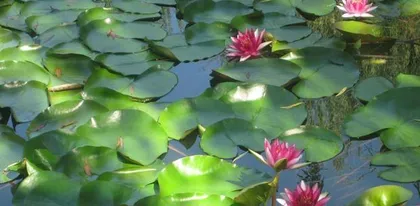Water lilies are beautiful and unique plants, often used to create beautiful waterscapes. However, many people encounter various problems when trying to cultivate water lilies, such as not knowing how to choose the right pond, soil, and fertilizers. This article will provide a detailed introduction to the cultivation methods and key care points for water lilies, helping readers solve various cultivation challenges and easily create a beautiful waterscape.

Table of Contents:
Choosing the Right Pond
Choosing the Right Soil
Choosing the Right Water Lily Variety
Controlling Water Temperature and Quality
Providing Adequate Sunlight and Nutrients
Proper Fertilization
Preventing Pests and Diseases
Regular Pruning and Cleaning
Changing Water and Renewing the Mud Bottom
Guarding Against Temperature Changes
Protecting the Dormancy Period
Seasonal Care
Choosing Compatible Companion Plants
Observation and Adjustment
Creating a Suitable Environment

Choosing the Right Pond
Water lilies have high requirements for ponds. It is best to choose a pond with a depth of about 50-70 cm and an area of more than 2 square meters to ensure they have enough space to grow.
Choosing the Right Soil
Water lilies prefer soft, muddy soil. It is recommended to use a mixture of garden soil, aquarium substrate, and leaf mold as the growing medium.
Choosing the Right Water Lily Variety
Different varieties of water lilies have different growing environments and care requirements. You should choose a variety that suits your specific situation.

Controlling Water Temperature and Quality
Water lilies require water temperatures above 20°C, and you must ensure the water is clean and hygienic by changing it regularly.
Providing Adequate Sunlight and Nutrients
Water lilies need plenty of sunlight and require the addition of appropriate nutrients, such as potassium and phosphorus.
Proper Fertilization
Fertilization for water lilies should be based on the needs of different growth seasons and varieties. Add organic fertilizer or phosphorus-potassium fertilizer regularly.
Preventing Pests and Diseases
Water lilies are susceptible to various pests and diseases. Pay attention to prevention and treatment, such as for duckweed disease and paramecium.
Regular Pruning and Cleaning
Water lilies need regular pruning of leaves and flowers, as well as clearing weeds and fallen leaves from the pond.
Changing Water and Renewing the Mud Bottom
Water lilies require regular water changes and the mud bottom should be renewed every 3-5 years to ensure their normal growth.
Guarding Against Temperature Changes
Water lilies need a stable temperature environment, so avoid drastic temperature fluctuations.
Protecting the Dormancy Period
Water lilies have a dormant period that requires special protection and care during the winter.
Seasonal Care
The care methods for water lilies vary by season; adjustments should be made in a timely manner according to the different seasons.
Choosing Compatible Companion Plants
Water lilies can be planted with other aquatic plants. Choosing suitable companion plants can create a more beautiful waterscape.
Observation and Adjustment
The growth status of water lilies requires constant observation and adjustment to detect and solve problems in a timely manner.
Creating a Suitable Environment
The care of water lilies relies on a suitable environment. Strive to create an environment that is conducive to their growth.
Through this article, readers should now have a grasp of the cultivation methods and care points for water lilies and can easily create a beautiful waterscape. During the cultivation process, it is important to pay close attention to the plant's growth status and required environment, and to adjust the care methods in a timely manner. We hope everyone can successfully grow healthy and beautiful water lilies.